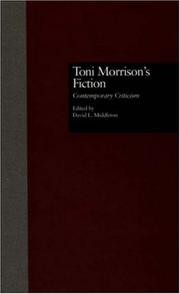Digital
ISBN: 9781800102118 Year: 2021 Publisher: Rochester, NY Camden House
Abstract | Keywords | Export | Availability | Bookmark
 Loading...
Loading...Choose an application
- Reference Manager
- EndNote
- RefWorks (Direct export to RefWorks)
Digital
ISBN: 9780511782282 Year: 2013 Publisher: Cambridge Cambridge University Press
Abstract | Keywords | Export | Availability | Bookmark
 Loading...
Loading...Choose an application
- Reference Manager
- EndNote
- RefWorks (Direct export to RefWorks)
Book
ISBN: 9781496804495 Year: 2014 Publisher: Jackson : University Press of Mississippi,
Abstract | Keywords | Export | Availability | Bookmark
 Loading...
Loading...Choose an application
- Reference Manager
- EndNote
- RefWorks (Direct export to RefWorks)
Toni Morrison: Memory and Meaning boasts essays by well-known international scholars focusing on the author's literary production and including her very latest works--the theatrical production Desdemona and her tenth and latest novel, Home. These original contributions are among the first scholarly analyses of these latest additions to her oeuvre and make the volume a valuable addition to potential readers and teachers eager to understand the position of Desdemona and Home within the wider scope of Morrison's career. Indeed, in Home, we find a reworking of many of the tropes and themes that run throughout Morrison's fiction, prompting the editors to organize the essays as they relate to themes prevalent in Home.In many ways, Morrison has actually initiated paradigm shifts that permeate the essays. They consistently reflect, in approach and interpretation, the revolutionary change in the study of American literature represented by Morrison's focus on the interior lives of enslaved Africans. This collection assumes black subjectivity, rather than argues for it, in order to reread and revise the horror of slavery and its consequences into our time. The analyses presented in this volume also attest to the broad range of interdisciplinary specializations and interests in novels that have now become classics in world literature. The essays are divided into five sections, each entitled with a direct quotation from Home, and framed by two poems: Rita Dove's "The Buckeye" and Sonia Sanchez's "Aaayeee Babo, Aaayeee Babo, Aaayeee Babo."

ISBN: 0815308698 Year: 1997 Publisher: New York, NY : Garland,
Abstract | Keywords | Export | Availability | Bookmark
 Loading...
Loading...Choose an application
- Reference Manager
- EndNote
- RefWorks (Direct export to RefWorks)
Book
ISBN: 9781496834171 Year: 2021 Publisher: Jackson : University Press of Mississippi,
Abstract | Keywords | Export | Availability | Bookmark
 Loading...
Loading...Choose an application
- Reference Manager
- EndNote
- RefWorks (Direct export to RefWorks)
Critics have routinely excluded African American literature from ecocritical inquiry despite the fact that the literary tradition has, from its inception, proved to be steeped in environmental concerns that address elements of the natural world and relate nature to the transatlantic slave trade, plantation labor, and nationhood. Toni Morrison's work is no exception. Toni Morrison and the Natural World: An Ecology of Color is the first full-length ecocritical investigation of the Nobel Laureate's novels and brings to the fore an unequaled engagement between race and nature. Morrison's ecological consciousness holds that human geographies are enmeshed with nonhuman nature. It follows, then, that ecology, the branch of biology that studies how people relate to each other and their environment, is an apt framework for this book. The interrelationships and interactions between individuals and community, and between organisms and the biosphere are central to this analysis. They highlight that the human and nonhuman are part of a larger ecosystem of interfacings and transformations. Toni Morrison and the Natural World is organized by color, examining soil (brown) in The Bluest Eye and Paradise; plant life (green) in Song of Solomon, Beloved, and Home; bodies of water (blue) in Tar Baby and Love; and fire (orange) in Sula and God Help the Child. By providing a racially inflected reading of nature, Toni Morrison and the Natural World makes an important contribution to the field of environmental studies and provides a landmark for Morrison scholarship.
Book
Year: 1999 Publisher: Dijon : E.U.D. (Editions universitaires de Dijon),
Abstract | Keywords | Export | Availability | Bookmark
 Loading...
Loading...Choose an application
- Reference Manager
- EndNote
- RefWorks (Direct export to RefWorks)
Dissertation
Year: 2003 Publisher: Liège : Université de Liège [ULg], Faculté de Philosophie et Lettres,
Abstract | Keywords | Export | Availability | Bookmark
 Loading...
Loading...Choose an application
- Reference Manager
- EndNote
- RefWorks (Direct export to RefWorks)
morrison (toni), 1931 --- -morrison (toni), 1931 --- -morrison (toni), 1931-
Dissertation
Abstract | Keywords | Export | Availability | Bookmark
 Loading...
Loading...Choose an application
- Reference Manager
- EndNote
- RefWorks (Direct export to RefWorks)
morrison (toni), 1931 --- -morrison (toni), 1931 --- -morrison (toni), 1931-
Book
Year: 1984
Abstract | Keywords | Export | Availability | Bookmark
 Loading...
Loading...Choose an application
- Reference Manager
- EndNote
- RefWorks (Direct export to RefWorks)
Morrison (toni), 1931 --- -Morrison (toni), 1931 --- -Morrison (toni), 1931-
Book
ISBN: 9780823239153 9780823239160 Year: 2013 Publisher: New York Fordham university press
Abstract | Keywords | Export | Availability | Bookmark
 Loading...
Loading...Choose an application
- Reference Manager
- EndNote
- RefWorks (Direct export to RefWorks)

 Search
Search Feedback
Feedback About UniCat
About UniCat  Help
Help News
News